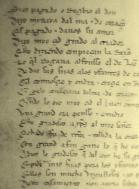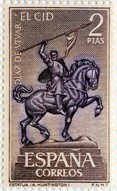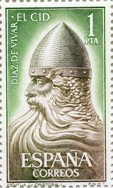The Song of My Cid
The Composition
The epic poem called "The Song of My Cid" is the first extensive narrative work in Spanish literature penned in a Romance language. It is composed of 3,735 anisosyllabic verses that relate heroic exploits freely adapted from the later years in the life of the Castilian nobleman Don Rodrigo Díaz de Vivar.
The poem is written in mediaeval Castilian and was composed around the year 1200 (between 1195 and 1207). The original title is not known, though it was probably called epic poem or song, terms the author uses to describe his work in verses 1085 and 2276 respectively.
The Narrative
The Song of My Cid addresses the subject of honor, a quality of prime importance to the people of that period. The need to restore lost honor is what drives the exploits undertaken by the hero.
The poem begins with the Cid's exile, the primary cause for dishonor, after an accusation of theft. This dishonor also means being deprived not only of his estate or possessions in Vivar but also of the custody of his family.
After concluding the conquest of Valencia, achieved by his good judgment and shrewdness, the hero receives the royal pardon and a new estate, the fiefdom of Valencia. In order to ratify his new status as lord over vassals, marriages are arranged for his daughters with lineages of the greatest prestige, such as those of the princes of Carrión.
Fortune, however, is fickle and this moment of happiness is turned into a new fall from honor for the Cid by reason of the grave offense caused by the princes against his daughters, who are humiliated, badly wounded and left abandoned in the oak forest of Corpes, an incident that under mediaeval law meant the de facto repudiation of the daughters by the Carrión household.
This leads the Cid to allege nullity of the marriages in a trial presided by the king. The princes of Carrion are publicly disgraced and despoiled of the privileges that they previously possessed as members of the royal entourage. El Cid's daughters on the other hand enter into arranged marriages with Spanish kings, thereby rising to the top of the social ladder.
The Author and the Manuscript
The Author
Although this is an anonymous work, an analysis of the preserved text shows that it belongs to a learned author who had an accurate knowledge of the law in force at the end of the 12th and beginning of the 13th centuries, and that he was familiar with the area around Burgos. Different theories have been put forward on his identity: it has been said he was a minstrel from Medinaceli, or one from San Esteban de Gormaz, that he was a poet from the Jiloca or Jalón river valleys and even that he was Jerome of Périgord.
In May of 1245 by the Julian calendar (1207 A.D.) an abbot who is identified simply as Pedro finished copying a manuscript of almost four thousand verses. In the conclusion he availed himself of the opportunity to request, in the ingrained tradition of mediaeval scribes, that he be given something in return: "quien escrivió este livro, dél[e] Dios paraíso.¡Amén! Per Abbat le escrivió en el mes de mayo, en era de M e CC e XLV años". ("Whosoever wrote this book, may God grant him paradise. Amen! Abbot Pedro wrote this in the month of May in the year of our Lord 1207.)
Abbot Pedro's copy contained an account of the life of Rodrigo Díaz de Vivar. This work, like so many coeval ones, lacked a title but would much later become known as the Song of My Cid or the Poem of My Cid. Abbot Pedro had copied, therefore, an earlier text whose date of authorship is still open to debate.
In the Middle Ages "to write" merely meant "to be the copyist". For what we understand today as the author it would have had to say "composed" or "made". This invalidates the theory of Colin Smith that the author was the Abbot Pedro.
The Manuscript

There is only one copy in existence and it is currently housed in the National Library (Biblioteca Nacional) in Madrid. It is a volume of 74 thick parchment sheets, three of which are missing, one from the beginning and two between pages 47/48 and 69/70. A further two sheets serve as flyleaves. Many of the pages have stains from the reagents that were utilized since the 16th century to facilitate the reading of what had probably faded. The binding of the tome dates from the 15th century. It is made of wood covered in dressed sheepskin leather with stamped ornamental scrolls.
The manuscript is a continuous text without any separation between the songs, or spacing between the verses. These always begin with a capital letter.
The legend
Nine centuries after the death of Rodrigo Díaz de Vivar and eight centuries after the legends of his exploits were written down in The Song of My Cid, this important figure continues to be a paradigm of the hero that arouses fascination and constitutes a source of inspiration.

Many of the events and exploits that are attributed to the Cid never happened, but they have helped to establish the myth. The Cid was the hero that the Spanish Christianity of the Middle Ages needed in that historical context: it was the era of the Crusades, the age of the Reconquest and of expansion southwards.
The historic figure that inspired the legend, Rodrigo Díaz de Vivar, was born in the village of Vivar (Burgos) around 1043. He commenced his life as a knight at the end of the reign of Ferdinand I.
He entered the service of one of the king's sons - Sancho II, king of Leon, after whose death he served underAlphonse VI. He married the Leonese noblewoman Jimena Diaz, the daughter of the count of Oviedo, who was descended from the kings of Leon. In 1081, banished into exile after a false accusation of theft, he offered his services to the Muslim rulers of Zaragoza. In 1088 he returned from exile to Castile, subsequently to defeat the king of Aragon and the count of Barcelona. In due course in 1094 he conquered an entire kingdom and became governor of Valencia.

A life that has earned a place in history, literature and the arts.
The Spanish Royal Mint, in deference to this masterpiece of Spanish mediaeval literature, has minted a set of three coins: an 8-reales coin in silver with a denomination of 10 Euros, a silver cincuentin with a denomination of 50 Euros, and a 4-escudo coin in gold with a denomination of 200 Euros.
